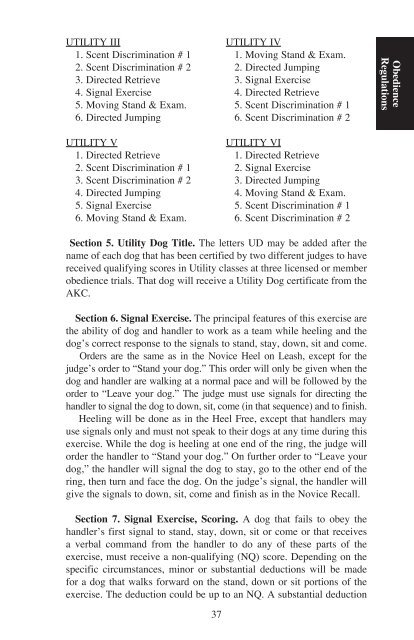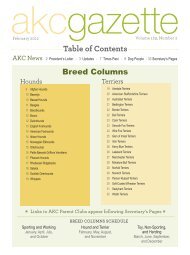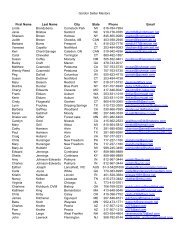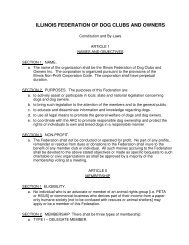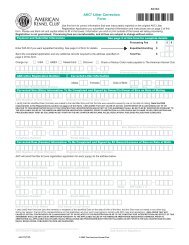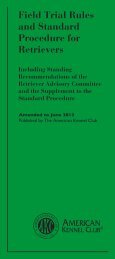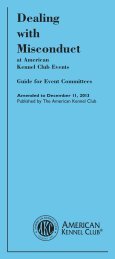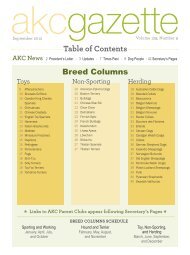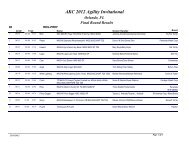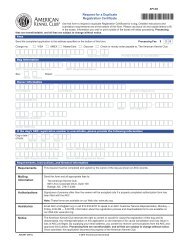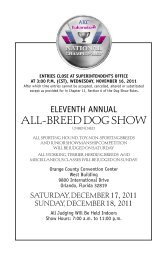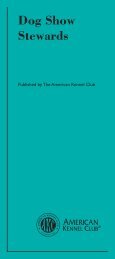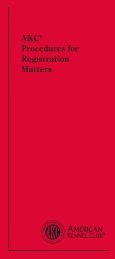Obedience Regulations - American Kennel Club
Obedience Regulations - American Kennel Club
Obedience Regulations - American Kennel Club
You also want an ePaper? Increase the reach of your titles
YUMPU automatically turns print PDFs into web optimized ePapers that Google loves.
utilitY iii utilitY iV<br />
1. scent Discrimination # 1 1. moving stand & exam.<br />
2. scent Discrimination # 2 2. Directed Jumping<br />
3. Directed retrieve 3. signal exercise<br />
4. signal exercise 4. Directed retrieve<br />
5. moving stand & exam. 5. scent Discrimination # 1<br />
6. Directed Jumping 6. scent Discrimination # 2<br />
utilitY V utilitY Vi<br />
1. Directed retrieve 1. Directed retrieve<br />
2. scent Discrimination # 1 2. signal exercise<br />
3. scent Discrimination # 2 3. Directed Jumping<br />
4. Directed Jumping 4. moving stand & exam.<br />
5. signal exercise 5. scent Discrimination # 1<br />
6. moving stand & exam. 6. scent Discrimination # 2<br />
Section 5. Utility Dog Title. the letters uD may be added after the<br />
name of each dog that has been certified by two different judges to have<br />
received qualifying scores in utility classes at three licensed or member<br />
obedience trials. that dog will receive a utility Dog certificate from the<br />
AKc.<br />
Section 6. Signal Exercise. the principal features of this exercise are<br />
the ability of dog and handler to work as a team while heeling and the<br />
dog’s correct response to the signals to stand, stay, down, sit and come.<br />
orders are the same as in the novice Heel on leash, except for the<br />
judge’s order to “stand your dog.” this order will only be given when the<br />
dog and handler are walking at a normal pace and will be followed by the<br />
order to “leave your dog.” the judge must use signals for directing the<br />
handler to signal the dog to down, sit, come (in that sequence) and to finish.<br />
Heeling will be done as in the Heel Free, except that handlers may<br />
use signals only and must not speak to their dogs at any time during this<br />
exercise. While the dog is heeling at one end of the ring, the judge will<br />
order the handler to “stand your dog.” on further order to “leave your<br />
dog,” the handler will signal the dog to stay, go to the other end of the<br />
ring, then turn and face the dog. on the judge’s signal, the handler will<br />
give the signals to down, sit, come and finish as in the novice recall.<br />
Section 7. Signal Exercise, Scoring. A dog that fails to obey the<br />
handler’s first signal to stand, stay, down, sit or come or that receives<br />
a verbal command from the handler to do any of these parts of the<br />
exercise, must receive a non-qualifying (nQ) score. Depending on the<br />
specific circumstances, minor or substantial deductions will be made<br />
for a dog that walks forward on the stand, down or sit portions of the<br />
exercise. the deduction could be up to an nQ. A substantial deduction<br />
37<br />
<strong>Obedience</strong><br />
<strong>Regulations</strong>


